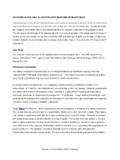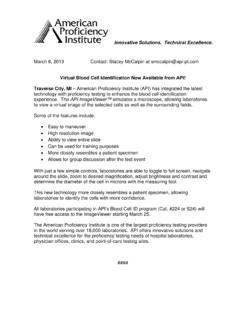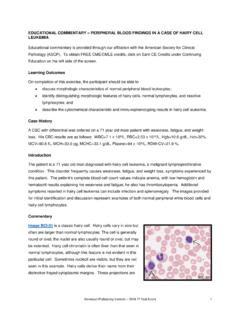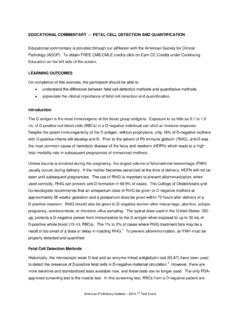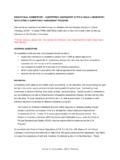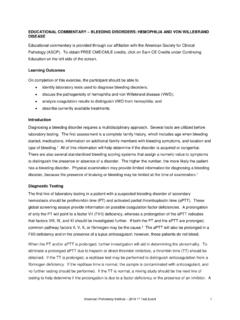Transcription of Blood Cell ID - Identifying Immature and …
1 American Proficiency Institute 2012 1stTest Event EDUCATIONAL COMMENTARY - Blood CELL ID: Identifying Immature AND abnormal cells LEARNING OUTCOMESOn completion of this exercise, the participant should be able to identify morphologic features of Immature neutrophils. describe morphologic characteristics of Immature erythrocytes. identify important features that distinguish giant Commentary The patient presented in this testing event has unspecified leukemia. The images represent both normal and abnormal cells seen on her peripheral Blood smear. The cell in Image BCI-01 is a nucleated red Blood cell (RBC). Although nucleated RBCs do not normally appear in the peripheral Blood of an adult, it is not unexpected in this patient s condition owing to hematopoietic bone marrow stress.
2 Nucleated RBCs are Immature erythrocytes that still retain their nucleus. The cell in this image is typical of those most often seen in the peripheral Blood of persons with leukemia. The chromatin is dense and clumped, with indistinct areas of parachromatin. The nucleus is eccentrically located within the cell. The cytoplasm stains pinkish, as in this example, or sometimes blue-gray. Nucleated erythrocytes represent defined stages in RBC maturation, but do not need to be classified when noted on a peripheral Blood smear. These cells should, however, be counted and BCI-02 illustrates a band or stab neutrophil. Band cells are the earliest precursors of neutrophil maturation that can be seen normally in the peripheral Blood .
3 The cell in this picture is a classic example of a band cell. The nucleus is shaped like the letters C or U. The chromatin is clumped and condensed. The cytoplasm contains numerous small, specific granules that give the cell a pinkish COMMENTARY - Blood CELL ID: Identifying Immature AND abnormal cells (cont.) American Proficiency Institute 2012 1stTest Event The cell depicted in Image BCI-03 is a metamyelocyte. Metamyelocytes are not normally seen in the peripheral Blood . Again, it is not surprising to identify a metamyelocyte in this case, because the bone marrow may be stressed. The nucleus in a metamyelocyte is characteristically only slightly indented or kidney-bean shaped.
4 At times it may be difficult to distinguish a metamyelocyte from a band, such as is seen in BCI-02. Both cells are about the same size. However, the nuclear indentation in the metamyelocyte is less than half the diameter of a hypothetical round nucleus. In comparison, the nucleus in the band is indented more than half the diameter of a possible round nucleus. The nuclear chromatin of a metamyelocyte is also dense and clumped, although some loose chromatin indicates the immaturity of the cell. Likewise, as in the band neutrophil, the cytoplasm of the metamyelocyte contains many small pink specific granules. The metamyelocyte in this image has retained some bluish cytoplasm.
5 Image BCI-04 features a normal lymphocyte. Mature lymphocytes vary in size; the cell shown here represents a smaller lymphocyte. In small lymphocytes, the nuclei are large in relation to a scanty amount of blue cytoplasm. The nuclei are often round, oval, or barely indented. The chromatin stains a dark purple and is clumped and dense. Sometimes nucleoli may be seen, as in this cell, but the dense chromatin indicates that the cell is mature. The arrow in Image BCI-05 identifies a giant platelet. The termgiant is used to describe a platelet that is larger than a normal RBC. Giant platelets vary in shape; they may be round, oval, or irregular. The periphery of the cell also varies and may be scalloped or smooth.
6 The cytoplasm is generally a light blue or blue-gray; it may be finely dispersed, or aggregates of granules may be visible. Sometimes no granules are apparent in this cell. This example shows small, fine granules. The vacuoles seen EDUCATIONAL COMMENTARY - Blood CELL ID: Identifying Immature AND abnormal cells (cont.) American Proficiency Institute 2012 1stTest Event are not characteristic of giant platelets and may indicate an aged cell or an artifact of smear preparation. It is also important to note that this giant platelet has no nucleus, so it should not be confused with a leukocyte of any type. Likewise, its large size and more granular cytoplasm should help distinguish it from a polychromatophilic erythrocyte.
7 Though polychromatophilic RBCs may be large, the normal mean corpuscular volume in this case study suggests that large erythrocytes are not present. Finally, a large platelet is present at about the six-o clock position in the same image. Although more granular and slightly more purple, this cell is more similar to the giant platelet than to other cells in the picture. A promyelocyte is pictured in Image should not be seen in normal peripheral Blood . Several morphologic features characterize promyelocytes. As Immature cells , they are frequently large. The nucleus may be round or oval and is sometimes eccentrically located within the cytoplasm. The dark purple chromatin is loose and open; nucleoli are often visible.
8 The cytoplasm may be blue or blue-gray. Numerous small violet or purple granules are present. In fact, these nonspecific cytoplasmic granules must be seen to classify a cell as a promyelocyte. Editor s notes:More participants identified the cell in Image BCI-06 as a myelocyte instead of a promyelocyte. This cell could be a late promyelocyte or early myelocyte. The large number of primary granules and the large size of this cell point to a promyelocyte. However, the lack of blue cytoplasm and the defined nucleolus, with the nuclear chromatin being slightly condensed, is suggestive of a more mature cell such as a myelocyte. The cell in Image BCI-07 is a blast. As with other cells presented in this testing event, blasts should not be seen in the peripheral Blood .
9 However, the appearance of such a cell is not unexpected in a patient with leukemia. Blasts are large cells , with a high nuclear-cytoplasmic ratio. The cytoplasm, in contrast to the promyelocyte shown in BCI-06, contains no granules, is scanty, and stains a dark blue. The nucleus is round or oval, with a loose, fine chromatin pattern. Sometimes, multiple prominent nucleoli are visible, as in this example. The large size, open chromatin, and prominent, multiple nucleoli help differentiate this cell from the normal lymphocyte in BCI-04. It is difficult to classify blasts according EDUCATIONAL COMMENTARY - Blood CELL ID: Identifying Immature AND abnormal cells (cont.) American Proficiency Institute 2012 1stTest Event to cell lineage based only on the appearance of Wright-stained cells , because blasts of various cell lines are similar in appearance.
10 Therefore, it is most important to count and report blasts, but additional techniques must be used to define cell type. Summary The patient presented in this testing event had several Immature and abnormal cells in her peripheral Blood . Appropriate identification and classification of these cells by the laboratory professional provides information important in determining a diagnosis. ASCP 2012
